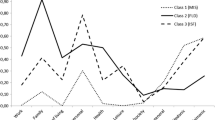Abstract
Satisfaction and happiness with life as a whole are analyzed in terms of satisfaction with health, finances, family, job, friends, housing, area, recreation, religion, self-esteem, transportation and government services for males and females. Patterns of influential variables differ for males and females. The perceived gap between what one has and wants is a better predictor of satisfaction than the gap between what one has and thinks similar others have, and the gap between what one has and the best one has had in the past. Domain-to-satisfaction and happiness explanations are combined with gap theoretic explanations to reveal the psychological dynamics of judgments of satisfaction for males and females for the 12 domains and global well-being.
Similar content being viewed by others
Bibliography
Andrews, F. M. and Withey, S. B.: 1976, Social Indicators of Well-Being (Plenum Press, New York).
Appelgryn, A. E. and Plug, C.: 1981, ‘Application of the theory of relative deprivation to occupational discrimination against women’, South African Journal of Psychology 11, pp. 143–147.
Austin, W., McGinn, N. C. and Susmilch, C.: 1980, ‘Internal standards revisited: effects of social comparisons and expectancies on judgments of fairness and satisfaction’, Journal of Experimental Social Psychology 16, pp. 426–441.
Bamundo, P. J. and Kopelman, R. E.: 1980, ‘The moderating effects of occupation, age, and urbanization on the relationship between job satisfaction and life satisfaction’, Journal of Vocational Behavior 17, pp. 106–123.
Bledsoe, J. C., Mullen, D. J. and Hobbs, G. J.: 1980, ‘Validity of the Mullen diagnostic survey for leadership improvement’, Perceptual and Motor Skills 50 (3, Pt. 1), pp. 838–846.
Booth, R. F., NcNally, M. S. and Berry, N. H.: 1979, ‘Hospital corpsmen perceptions of working in a fleet Marine force environment’, Military Medicine 144, pp. 31–34.
Campbell, A., Converse, P. E. and Rodgers, W. L.: 1976, The Quality of American Life (Russell Sage Foundation, New York).
Canter, D. and Rees, K.: 1982, ‘A multivariate model of housing satisfaction’, International Review of Applied Psychology 31, pp. 185–208.
Frank, E., Anderson, C. and Rubinstein, D.: 1979, ‘Marital role strain and sexual satis-faction’, Journal of Consulting and Clinical Psychology 47, pp. 1096–1103.
Glatzer, W. and Volkert, M.: 1980, ‘Living conditions and the quality of life of older people’, Zeitschrift für Gerontologie 13, pp. 247–260.
Handal, P. J., Barling, P. W. and Morrissy, E.: 1981, ‘Development of perceived and preferred measures of physical and social characteristics of the residential environment and their relationship to satisfaction’, Journal of Community Psychology 9, pp. 118–124.
Humphrys, P.: 1981, ‘The effect of importance upon the relation between perceived job attributes, desired job attributes and job satisfaction’, Australian Journal of Psychology 33, pp. 121–133.
Kopelman, R. E.: 1979, ‘Directionally different expectancy theory predictions of work motivation and job satisfaction’, Motivation and Emotion 3, pp. 299–317.
Land, K. C.: 1969, ‘Principles of path analysis’, Sociological Methodology: 1969, ed. by E. F. Borgatta (Jossey Bass, San Francisco).
Medley, M. L.: 1980, ‘Life satisfaction across four stages of adult life’, International Journal of Aging and Human Development 11, pp. 193–209.
Michalos, A. C.: 1980, ‘Satisfaction and happiness’, Social Indicators Research 8, pp. 385–422.
Michalos, A. C.: 1982, ‘The satisfaction and happiness of some senior citizens in rural Ontario’, Social Indicators Research 11, pp. 1–30.
Oldham, G. R. and Miller, H. E.: 1979, ‘The effect of significant other's job complexity on employee reactions to work’, Human Relations 32, pp. 247–260.
Oliver, R. L.: 1980, ‘A cognitive model of the antecedents and consequences of satis-faction decisions’, Journal of Marketing Research 17, pp. 460–469.
Peterson, M. F.: 1979, ‘Leader behavior, group size, and member satisfaction in university Christian growth groups’, Journal of Psychology and Theology 7, pp. 125–132.
Rakestraw, T. L. and Weiss, H. M.: 1981, ‘The interaction of social influences and task experience on goals, performance, and performance satisfaction’, Organizational Behavior and Human Performance 27, pp. 326–344.
Rice, R. W. and Near, J. P.: 1980, ‘The job-satisfaction/life-satisfaction relationship: a review of empirical research’, Basic and Applied Social Psychology 1, pp. 37–64.
Roessler, R. T. and Boone, S. E.: 1979, ‘The relationship of person/environment fit to client perceptions and performance in a rehabilitation center’, Rehabilitation Psychology 26, pp. 145–154.
Soper, W. B.: 1980, ‘Relationships between subjectively and statistically determined contributors to life satisfaction for male university faculty’, Psychological Reports 46 (3, Pt 1), pp. 731–734.
Taylor, M. C.: 1982, ‘Improved conditions, rising expectations, and dissatisfaction: a test of the past/present relative deprivation hypothesis’, Social Psychology Quarterly 45, pp. 24–33.
Thomas, L. E. and Robbins, P. I.: 1979, ‘Personality and work environment congruence of mid-life career changers’, Journal of Occupational Psychology 52, pp. 177–183.
Wood, D. A.: 1981, ‘The relation between work values and the perception of the work setting’, Journal of Social Psychology 115, pp. 189–193.
Wright, D. and Gutkin, T. B.: 1981, ‘School psychologists’ job satisfaction and discrepancies between actual and desired work functions’, Psychological Reports 49, pp. 735–738.
Author information
Authors and Affiliations
Additional information
This is my last report written in collaboration with the Rural Development Outreach Project (RDOP) and sponsored by RDOP and the Social Sciences and Humanities Research Council of Canada. Again, I want to thank F. M. Andrews, D. Bell. C. C. Clogg, M. Dahms, A. M. Fuller, J. Kotarski, D. C. Poff, R. A. J. Ross, B. A. Rozee and J. S. Wolfe, I am responsible for the final product, but without their help there would have been no product at all.
Rights and permissions
About this article
Cite this article
Michalos, A.C. Satisfaction and happiness in a rural northern resource community. Social Indicators Research 13, 225–252 (1983). https://doi.org/10.1007/BF00318099
Received:
Issue Date:
DOI: https://doi.org/10.1007/BF00318099




